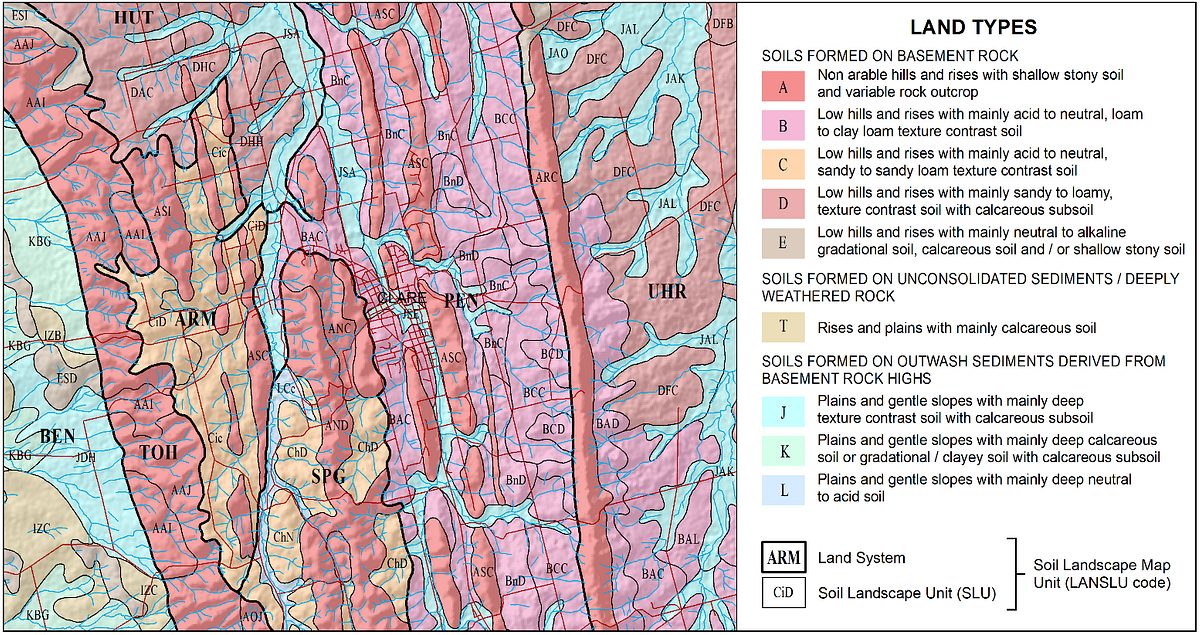Mapping soil and land
The State Land and Soil Mapping Program (1986–2012) developed a consistent and comprehensive coverage of soil and land mapping information for South Australia. This was achieved through a campaign of extensive field investigations, stereoscopic analyses of aerial photographs and expert interpretation, together with various other forms of analysis. See Land Resources Soils (environment.sa.gov.au). A range of information and datasets have been produced that are suitable for a range of uses, including planning, policy development and guiding on-ground decisions.
Base mapping is at 1:100,000 scale, with finer resolution mapping (1:50,000) available in the higher rainfall and more intensively used areas of South Australia, as shown in this scale and coverage map. A variety of data and information has been developed:
- a nested hierarchy of mapping units (see below)
- land type mapping (including development of 28 ‘land type’ concepts)
- mapping of a comprehensive suite of soil and land attributes.
- description of approximately 30,000 sites and soil profiles
- detailed physical, chemical and interpretive information for over 1000 excavated ‘soil characterisation sites’
- a range of landscape models designed to answer specific questions associated with land use and management (eg land use potential, environmental risk).
A nested hierarchy of mapping has been developed delineating areas with different soils, topography, geology, vegetation, land use and climate. Mapping units comprise (from largest to smallest size):
- biophysical regions
- biophysical subregions
- land zones (incomplete)
- land systems (see examples of land system mapping and a land system report)
- soil landscape map units (for example, refer to fact sheet).
As the complexity and diversity of soil and landscapes typically cannot be shown at the scale of mapping, the smallest map units (soil landscapes) may contain spatially undefined facets (landscape or soil components). While these components are not mapped explicitly, their areal proportion within each map unit is recorded in linked data tables. Conditions relating to a range of soil and land attributes are also described for each component area.

This system enables a very flexible approach for highlighting conditions and scenarios of interest for policy, planning and on-ground works, while also retaining more detailed soil and land information (covering all soil landscape map unit component areas) for use in quantitative and qualitative analyses. For example, the calculation of total areas corresponding to different soil and land conditions (such outputs are called ‘spatial data statistics’) requires analyses to be performed across all spatially undefined component areas. In contrast, map products (and map legend categories) display a carefully considered simplified representation of the more detailed underlying data.
Common examples of mapping formats include:
- showing only the most common (or dominant) occurrence within a map unit
- area-weighted average values calculated across all components of a map unit (if attribute data is quantitative in nature)
- the prevalence of a particular attribute condition (eg high levels of salinity), or combination of attribute conditions, expressed as “proportion of the landscape with …”
Find out more:
- Soil and land mapping fact sheet
- See our data on NatureMaps > Soils
- Fact sheets, Land system reports, and more on Enviro Data SA


